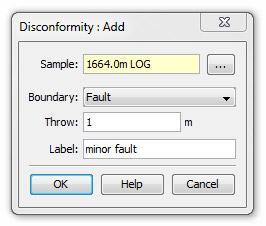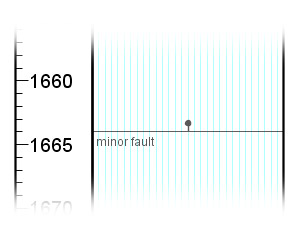Disconformities
Disconformities are unconformities (including hiatuses) and faults. They can be defined formally and informally in various ways:
- Interval boundaries - usually using LOG samples; all interval boundaries at the sample use a disconformable boundary type.
- Sequence picks - using LOG sample, the disconformity is formally identified as a surface from a sequence scheme.
- Depth/age curve - specifies the depth and also the duration (in Ma) of the disconformity. Use to create LOG samples for interval boundaries and sequence picks.
- Disconformity data type (see below).
Disconformity Data Type
Use this data type to specify a disconformity which is not formally identified as a surface and not part of your depth/age interpretation. You may give it a label and display it in interval chart panels. Interval boundary types at the chosen sample will default to the disconformity type (and produce a warning if this is changed). You can update all boundary types at the chosen sample by changing the disconformity type.
Enter disconformities from the Interpretations tab in Samples & Interpretations. Select the Disconformities tab.
 |
Disconformities are subject to versions - make sure you have the appropriate version selected before entering your data. You must select a sample. Usually this will be a LOG sample type. You must also select a disconformable boundary type. Fault types must have a throw (which can be positive or negative). The label is optional. |
 |
ChartsFor interval panel types, set the "disconformities" option on. Disconformities show drawn across the panel if there is no interval with a boundary at that sample. |
Page last updated: 26-Nov-2015 10:19